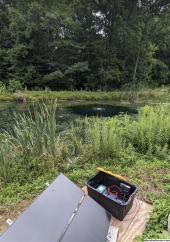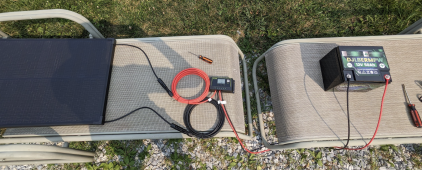Update:
The system has been installed and running successfully for three weeks now! Thanks again for everyone's input. Additional info & questions below..

 PV -> SCC -> lifepo4 battery -> inverter -> wall timer -> pump
I haven't configured the SCC yet for the lifepo4 battery, because it requires "advanced" settings (no pre-configured option).
PV -> SCC -> lifepo4 battery -> inverter -> wall timer -> pump
I haven't configured the SCC yet for the lifepo4 battery, because it requires "advanced" settings (no pre-configured option). I should get on this.
My current dilemma:
I've been experimenting with the wall timer in terms of number of hours and times of day that the pump is enabled. On hot & sunny days I've easily gotten 12 hours without draining the battery below 80%; on some rainy days I've either scaled it back to 3-4 hours, or accidentally drained the battery.
The SCC has a bluetooth listener, but is not connected to wifi or 5g - so in order to get readings on battery charge level and charging status, I need to be within ~100 feet. I've been checking a couple times per day (and adjusting the timer settings up or down accordingly) - but won't be willing to continue this indefinitely.
Twice, the battery has been drained to the point where the inverter shuts off. This stops the wall timer (obviously), which necessitates resetting both that and the inverter. Since I have the equipment locked up in the bin, it's a modest hassle.
At one point I recall being cautioned against connecting an inverter directly to the DC load ports of the SCC - because the load pulled by the inverter would be likely to overload the controller - which is why I have it connected this way instead. But I'm very foggy on those details..
Now I'm really wishing I could connect the inverter to the controller, to better monitor & control disconnect - well before the battery gets close to 0% (although from what I understand that's not very damaging for a lifepo4, as compared with other battery types (?))
The
details:
- Charge controller is an HQST 20A
- Giandel 12V DC inverter with No Load Current of 0.8A and Output Power of 600W (surge 1200W).
- Pump is 120 VAC; 1.3A; 51 Watts
Can you advise on whether it's
safe / advisable to connect the inverter directly to the SCC in this arrangement?
Thank you!





